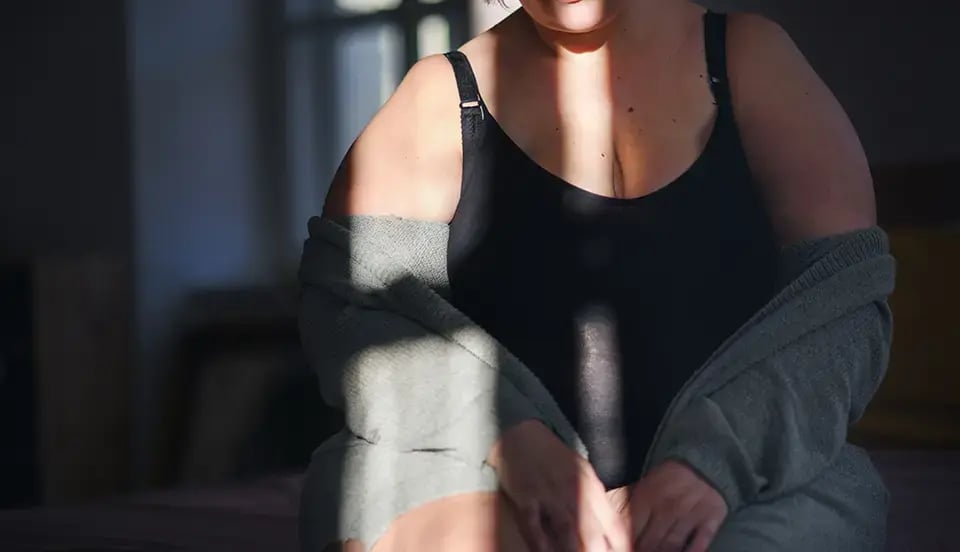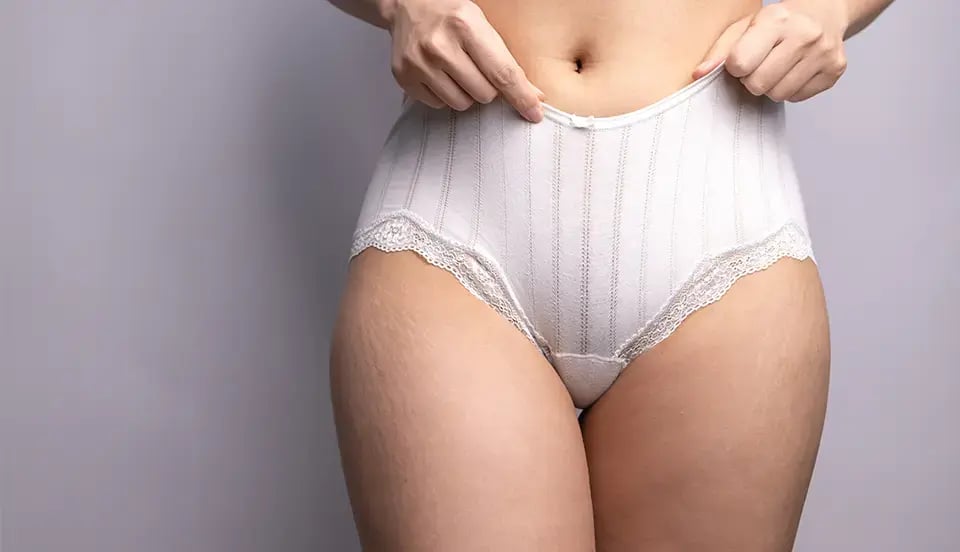What is Lipedema?
Enhancing Quality of Life: The Synergy of Treatments for Lipedema Management
This article explains lipedema, including its symptoms, causes, treatment options, and ways to manage it yourself.
This disease primarily affects women, and doctors often misdiagnose it as obesity or lymphedema.
It typically starts during puberty, pregnancy, or menopause and can progress over time.
Primarily impacts the lower limbs, causing an abnormal, symmetrical buildup of subcutaneous fat.
Unlike regular weight gain, this fat is painful and resistant to diet and exercise.
Symptoms of Lipedema
It makes legs and arms accumulate too much fat, causing an uneven fat distribution. People often describe this fat as having a "column-like" or "tree-trunk" appearance. Symptoms of lipoedema:
1. Pain and Tenderness: Individuals with lipedema may experience pain, tenderness, or aching sensations in the affected areas. This discomfort can vary from mild to severe.
2. Swelling: Swelling, particularly in the lower limbs, is a common symptom. Swelling can worsen with prolonged standing or sitting.
3. Easy Bruising: It can lead to easy bruising, even with minimal trauma. The skin may also become sensitive to touch.
4. Decreased Mobility: The increased weight and size of the affected limbs may compromise mobility.
Causes of Lipedema
Hormonal factors, such as changes during puberty or menopause, may trigger its onset.
Some studies also suggest that some disturbances play a role in the development of it.

Diagnosis Lipedema
This could involve a check-up. It may also involve looking at medical history. Additionally, doctors may use tests like lymphoscintigraphy or MRI scans to rule out other problems.
Treatment Options for Lipedema
1. Compression Therapy: Wearing compression garments like compression stockings or sleeves can help reduce swelling and relieve pain.
2. Physical Therapy: Physical therapy exercises can improve mobility, strengthen muscles, and reduce discomfort.
3. Liposuction: In some cases, doctors may recommend liposuction to remove excess fat deposits. Doctors often use water-assisted liposuction and tumescent liposuction for patients.
4. Lymphatic Drainage: Manual lymphatic drainage techniques can aid in reducing swelling and improving lymphatic function.
Self-Management Strategies for Lipedema
1. Healthy Diet: Maintaining a healthy diet can help prevent additional weight gain.
2. Regular Exercise: Gentle, low-impact exercises like swimming or walking can help improve circulation and reduce discomfort.
3. Elevating Legs: Elevating the legs when resting can help reduce swelling.
4. Skin Care: Proper skin care, including moisturizing and protecting against injuries, is essential for managing it.

What to Do if You Suspect Lipedema
Early diagnosis and intervention can help prevent the condition from progressing and improve your overall well-being.
Compression Therapy of Lipedema
This therapy is a non-invasive approach to managing and can relieve pain and discomfort.
Our mission is to create a world where every investment in modern beauty is Worth It.
Let's keep in touch
Get updates of the treatments you are interested
Liposuction for Lipedema
Special liposuction methods like water-assisted or tumescent liposuction can remove extra fat in affected areas.
Liposuction can substantially improve the appearance and quality of life of individuals with lipedema.

Combining Treatments of Lipedema
Compression therapy prepares tissue for liposuction, which removes stubborn fat that compression therapy alone may not fully treat.
This is a challenging condition that can significantly impact the lives of those affected.
Compression therapy and liposuction can help treat lipedema symptoms and improve the quality of life for those affected.
Consulting a lipedema specialist for personalized treatment options that suit individual circumstances is crucial.
Lipedema, often mistaken for simple weight gain, can significantly impact one's quality of life. Managing and treating it requires a different approach aimed at improving symptoms and preventing further progression.
Lipedema primarily affects the lower body, including the hips, thighs, buttocks, and sometimes the arms. Lipedema fat is different from regular fat and causes uneven body shapes and problems with managing weight.
Symptoms differ but often include heavy or uncomfortable limbs, easy bruising, and heightened sensitivity to touch. Over time, untreated lipedema can lead to complications such as chronic venous insufficiency, which negatively impacts circulation and further exacerbates the condition.
Utilizing compression garments or bandages helps to alleviate swelling, improve circulation, and reduce discomfort. Graduated compression garments provide varying pressure levels, promoting better lymphatic drainage and managing fluid retention commonly associated with lipedema.
To stay healthy, it's important to eat well and exercise regularly. This can help manage symptoms and prevent gaining more weight, even if losing weight in specific areas is difficult.
Manual lymphatic drainage massage can assist in reducing swelling and improving lymphatic flow in affected areas. This technique, performed by trained professionals, helps in managing the symptoms of lipedema, maintain a healthy weight.
Surgical options like liposuction specifically designed for lipoedema patients for long term conditions. These procedures aim to remove excess fat while preserving lymphatic structures, providing long-term improvement in symptoms.
The Importance of Comprehensive Care:
Managing lipedema can be challenging,
- a combination of therapies encompassing lifestyle changes,
- compression therapy,
- lymphatic drainage techniques,
- surgical interventions
can significantly improve the lives of individuals affected by this condition.
Enhancing Quality of Life: The Synergy of Treatments for Lipedema Management
This article explains lipedema, including its symptoms, causes, treatment options, and ways to manage it yourself.
This disease primarily affects women, and doctors often misdiagnose it as obesity or lymphedema.
It typically starts during puberty, pregnancy, or menopause and can progress over time.
Primarily impacts the lower limbs, causing an abnormal, symmetrical buildup of subcutaneous fat.
Unlike regular weight gain, this fat is painful and resistant to diet and exercise.
Symptoms of Lipedema
It makes legs and arms accumulate too much fat, causing an uneven fat distribution. People often describe this fat as having a "column-like" or "tree-trunk" appearance. Symptoms of lipoedema:
1. Pain and Tenderness: Individuals with lipedema may experience pain, tenderness, or aching sensations in the affected areas. This discomfort can vary from mild to severe.
2. Swelling: Swelling, particularly in the lower limbs, is a common symptom. Swelling can worsen with prolonged standing or sitting.
3. Easy Bruising: It can lead to easy bruising, even with minimal trauma. The skin may also become sensitive to touch.
4. Decreased Mobility: The increased weight and size of the affected limbs may compromise mobility.
Causes of Lipedema
Hormonal factors, such as changes during puberty or menopause, may trigger its onset.
Some studies also suggest that some disturbances play a role in the development of it.

Diagnosis Lipedema
This could involve a check-up. It may also involve looking at medical history. Additionally, doctors may use tests like lymphoscintigraphy or MRI scans to rule out other problems.
Treatment Options for Lipedema
1. Compression Therapy: Wearing compression garments like compression stockings or sleeves can help reduce swelling and relieve pain.
2. Physical Therapy: Physical therapy exercises can improve mobility, strengthen muscles, and reduce discomfort.
3. Liposuction: In some cases, doctors may recommend liposuction to remove excess fat deposits. Doctors often use water-assisted liposuction and tumescent liposuction for patients.
4. Lymphatic Drainage: Manual lymphatic drainage techniques can aid in reducing swelling and improving lymphatic function.
Self-Management Strategies for Lipedema
1. Healthy Diet: Maintaining a healthy diet can help prevent additional weight gain.
2. Regular Exercise: Gentle, low-impact exercises like swimming or walking can help improve circulation and reduce discomfort.
3. Elevating Legs: Elevating the legs when resting can help reduce swelling.
4. Skin Care: Proper skin care, including moisturizing and protecting against injuries, is essential for managing it.

What to Do if You Suspect Lipedema
Early diagnosis and intervention can help prevent the condition from progressing and improve your overall well-being.
Compression Therapy of Lipedema
This therapy is a non-invasive approach to managing and can relieve pain and discomfort.
Our mission is to create a world where every investment in modern beauty is Worth It.
Let's keep in touch
Get updates of the treatments you are interested
Liposuction for Lipedema
Special liposuction methods like water-assisted or tumescent liposuction can remove extra fat in affected areas.
Liposuction can substantially improve the appearance and quality of life of individuals with lipedema.

Combining Treatments of Lipedema
Compression therapy prepares tissue for liposuction, which removes stubborn fat that compression therapy alone may not fully treat.
This is a challenging condition that can significantly impact the lives of those affected.
Compression therapy and liposuction can help treat lipedema symptoms and improve the quality of life for those affected.
Consulting a lipedema specialist for personalized treatment options that suit individual circumstances is crucial.
Lipedema, often mistaken for simple weight gain, can significantly impact one's quality of life. Managing and treating it requires a different approach aimed at improving symptoms and preventing further progression.
Lipedema primarily affects the lower body, including the hips, thighs, buttocks, and sometimes the arms. Lipedema fat is different from regular fat and causes uneven body shapes and problems with managing weight.
Symptoms differ but often include heavy or uncomfortable limbs, easy bruising, and heightened sensitivity to touch. Over time, untreated lipedema can lead to complications such as chronic venous insufficiency, which negatively impacts circulation and further exacerbates the condition.
Utilizing compression garments or bandages helps to alleviate swelling, improve circulation, and reduce discomfort. Graduated compression garments provide varying pressure levels, promoting better lymphatic drainage and managing fluid retention commonly associated with lipedema.
To stay healthy, it's important to eat well and exercise regularly. This can help manage symptoms and prevent gaining more weight, even if losing weight in specific areas is difficult.
Manual lymphatic drainage massage can assist in reducing swelling and improving lymphatic flow in affected areas. This technique, performed by trained professionals, helps in managing the symptoms of lipedema, maintain a healthy weight.
Surgical options like liposuction specifically designed for lipoedema patients for long term conditions. These procedures aim to remove excess fat while preserving lymphatic structures, providing long-term improvement in symptoms.
The Importance of Comprehensive Care:
Managing lipedema can be challenging,
- a combination of therapies encompassing lifestyle changes,
- compression therapy,
- lymphatic drainage techniques,
- surgical interventions
can significantly improve the lives of individuals affected by this condition.



.webp?width=738&height=510&name=liposuction%20(1).webp)

